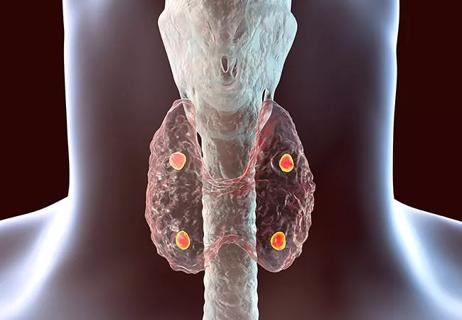How the approach helps Cleveland Clinic surgeons refine assessment precision

A novel technique using the autofluorescence patterns of parathyroid glands has been found to be 95% accurate in predicting normal versus abnormal glands and 84% accurate in predicting subclasses of parathyroid pathologies. The findings, which appeared in Surgery, are the first to report objective algorithms using quantified autofluorescence data to intraoperatively assess parathyroid glands in primary hyperparathyroidism (PHPT).
Advertisement
Cleveland Clinic is a non-profit academic medical center. Advertising on our site helps support our mission. We do not endorse non-Cleveland Clinic products or services. Policy
“Parathyroid surgery is a challenging type of endocrine surgery because the interpretation of which glands are abnormal and which glands are normal requires a significant expertise,” says Eren Berber, MD, Director of Robotic Endocrine Surgery, the Liver Tumor Ablation Program and the Neuroendocrine/Adrenal Tumor Center at Cleveland Clinic and the principal investigator of the study. “With this study, we are introducing an artificial intelligence-based algorithm that can help surgeons in assessing the parathyroid glands based on autofluorescence patterns during parathyroid surgery.”
After exposing parathyroid glands to near-infrared imaging (NIFI), autofluorescence measurements were done which involved a certain methodology, i.e. the parathyroid intensity was normalized by the background autofluorescence intensity. The surgeon would also measure the standard deviation of the signal to quantify the heterogeneity index (HI) of the autofluorescence pattern. Based on intraoperative and pathologic data, each parathyroid gland was categorized as abnormal, including either a single adenoma, double adenoma or hyperplasia, or as normal, which constituted a suppressed gland.
“We quantified how bright and how homogenous the autofluorescence signal from each gland was. It turns out that our normal glands are darker and uneven in the brightness pattern,” says Dr. Berber. “They’re heterogeneous regarding that light signal, and we can actually use software to measure this.”
The study included 98 patients who underwent bilateral, six patients who underwent unilateral, and two patients who underwent focal exploration for sporadic first-time primary hyperparathyroidism. Seventy-eight patients (74%) had a single adenoma, 16 patients (15%) had double adenomas, and 12 patients (11%) had hyperplasia. Of the 149 abnormal glands, 58 (39%) overlapped with normal glands in terms of their size, and 131 (88%) were parathyroid hormone hypersecreting. Overall, abnormal (n = 149) versus normal glands (n = 184) had a lower normalized autofluorescence pixel intensity (1.8 [0.7] vs 2.3 [1.1] pixels, respectively; P = .000), and they also had a higher degree of HI (0.17 [0.08] vs 0.10 [0.04], respectively; P = .000). In this cohort, all patients were cured based on their follow up labs.
Advertisement
“We were able to acquire a large amount of data, which we loaded into a machine learning artificial intelligence platform,” explains Dr. Berber. “We identified the normal and abnormal parathyroid glands based on their hormone secretion and pathology. Then, the machine learning was able to generate an algorithm about which parameters were linked with an abnormal versus normal parathyroid gland. This algorithm will help increase the precision of parathyroid surgery for patients at Cleveland Clinic.”
Dr. Berber also hopes to replicate this study in the next six months but this time using the next generation of technology. He would also like to include more surgeons to increase the amount of available data for collection and validate the model created. “Basically, I designed and led this study,” says Dr. Berber. “So, with this newer technology, we’re going to update the algorithm and determine how useful it is for Cleveland Clinic surgeons who have not used it; that’s the next step of validation.”
Advertisement
Advertisement

A weight-management program plus anti-obesity medication performs well

TRANSITION-T2D RCT results for patients with T2D receiving MDI

Incidence, outcomes and management

Cleveland Clinic endocrinologists work to identify protocols for improving care

Cleveland Clinic’s Endocrinology & Metabolism Institute is working to offer novel opportunities and therapies for diabetes and kidney disease

New findings indicate the importance of achieving sufficient sleep levels in regard to personal glucose targets

A recent study evaluates the correlation between preoperative calcium and parathyroid hormone values as predictors of gland volume and multi-gland disease

A look at how to asses hCG elevation